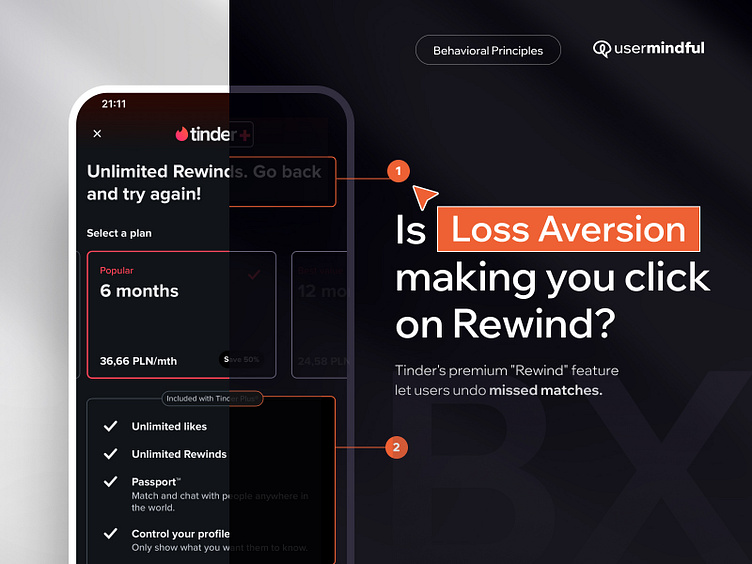Is Loss Aversion making you click on Rewind?
Loss aversion highlights what users stand to lose if they don't act now, generating FOMO.
IMPACT: Increases engagement and upgrades by motivating users to act on emotions and decide to buy subscription on Tinder!
You see that potential match disappear after an accidental left swipe – and suddenly your heart sinks. That's not just regret, that's FOMO (fear of missing out) in action! Tinder knows that the thought of losing a potential connection can be stronger than the excitement of finding one. Suddenly, it's not just about swiping, it's about reversing that missed opportunity before someone else snatches them up.
Additionally, buying a subscription guarantees user that this unpleasant feeling won’t come again as long as the subscription is active.
According to Daniel Kahneman and Amos Tversky the pain of losing something feels roughly 250% stronger than the joy of gaining the same thing. This highlights the need for UX designers to prioritize minimizing potential user frustrations and focus on offering solutions that make the regret reversible.
What is Loss Aversion?
Loss aversion is the subjective tendency to prefer avoiding losses over similar gains.Loss aversion is like the feeling where you'd rather not lose something than gain something of the same value. It's like when you really don't want to lose what you have, even more than you want to get something new. This makes you make choices where you try to avoid bad stuff from happening, even if sometimes it means you might miss out on good things.
See how this behavioral principle is used to impact your perception and motivation in UX:
See detailed breakdown with all examples on UserMindful.Design
See detailed breakdown on Behance
Other Principles:
Read about Social Proof and see how it influences your decision-making through the behavior and opinions of others.
Read about Endowment Effect and how it's used to keep you loyal
Read about Uncertainty and how it stops you from taking action
__________
Behavior Design:
As UserMindful.Design we aim to introduce behavioral frameworks, models and methods closer to the UX community in order to support development of ethical, inherently engaging digital products that redefine how people connect, thrive and persevere.
Contact us: contact@usermindful.design
Follow us on Behance
__________
Disclaimer:
*This material is created for educational and analytical purposes only. UserMindful is not affiliated with, endorsed by, or sponsored by Tinder or its parent company. All logos and trademarks used in this material belong to their respective owners and are included here under fair use for educational purposes. This work is independent and has not been authorized, sponsored, or otherwise approved by Tinder.
